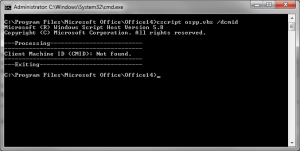So we had a few users delete their OneNote printer from the Printers List in Windows. OneNote is a great program and is bolstered by the use of the printer allowing you to push pretty much anything into OneNote. We ran an office repair but the printer didn’t actually return for our users, so I started looking at how the OneNote printer is configured and created a new instance of the printer. The following is basically a walk through of installing and configuring a local printer for OneNote 2010 (also applies to OneNote 2007).
First off we need to install the generic printer driver in Windows. To do this, follow these steps:
- Click Start, type printers in the Start Search box, and then click Devices and Printers in the Programs list.
- On the left side of the page near the top, click Add a printer.
- In the Add Printer dialog box, click Add a local printer.
- Click to select the Use an existing port option, select the appropriate port, and then click Next. For example, you can select LPT1.
- Under Manufacturer, select Generic, select Generic / Text Only under Printers, and then click Next.
- If you receive a message about drivers, click to select the Use the driver that is currently installed (recommended) option, and then click Next:
- Click Next, and then click Finish.
So now how do we go about configuring this newly installed generic printer for use with OneNote, follow these instructions for doing that:
- In the printer list, right-click the Generic / Text only printer, and then click Printer Properties.
- Click the Ports tab, and then click to select the Send To Microsoft OneNote Port check box.
- Click the Advanced Tab, select Send to Microsoft OneNote Driver in the Driver list, and then click Print Processor.
- Under Print processor, select winprint, select RAW under Default data type, and then click OK.
- Click the General tab, change the name of the printer to Send To OneNote 2010, and then click OK.
And now we can finally use the printer to submit pretty much anything to OneNote 2010. We didn’t really learn why the Office repair didn’t re-add the printer as the research we found on the internet led us to believe that it would add the printer, but just in case it doesn’t you now know how to manually add it.
